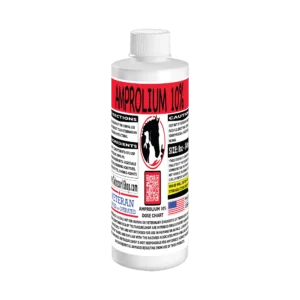-
Animal Products
Amprolium Wormer
$5.95 – $54.95 Select options This product has multiple variants. The options may be chosen on the product pageRated 0 out of 5
Amprolium Wormer
At Amprolium Wormer, we understand how important it is to keep your livestock and poultry healthy. Coccidiosis, a parasitic disease, can cause serious harm to your animals, leading to weight loss, poor growth, and even death. That’s why we’ve created a fast-acting and highly effective solution to help you manage and prevent this disease. Whether you have a small farm or a large-scale operation, Amprolium Wormer is here to ensure the health and well-being of your animals.
Why Choose Amprolium Wormer?
Amprolium Wormer is a powerful liquid solution specially designed to treat and prevent coccidiosis in a variety of animals. This easy-to-use product is trusted by farmers, veterinarians, and animal care professionals worldwide. Our goal is to provide you with a reliable and efficient tool for keeping your herd or flock healthy and productive.
Key Benefits of Amprolium Wormer:
Effective Coccidiosis Control: Amprolium Wormer targets the protozoan parasites that cause coccidiosis. It helps reduce the spread of the disease and ensures your animals recover quickly.
Fast Action: This solution works fast to eliminate parasites, giving your animals immediate relief from the effects of coccidiosis.
Wide Use for Different Animals: Amprolium Wormer is suitable for a variety of animals, including cattle, chickens, goats, sheep, and turkeys, making it a versatile choice for all your livestock and poultry needs.
Easy to Use: The liquid solution can be easily mixed with water or feed, ensuring that all your animals get the proper dose with minimal effort.
Our Parent Company – Toltrazuril Shop
Amprolium Wormer is part of Toltrazuril Shop, a leader in providing trusted solutions for managing animal health. For years, Toltrazuril Shop has been dedicated to offering high-quality products that help farmers and animal owners maintain the health of their herds and flocks. With a wide range of reliable and effective solutions, Toltrazuril Shop continues to be a top choice for animal care professionals worldwide.
How Amprolium Wormer Works:
Coccidiosis is caused by protozoan parasites that infect the digestive systems of animals. These parasites can severely damage tissues, leading to illness and, in some cases, death. Amprolium Wormer works by inhibiting the growth of these parasites, allowing your animals to recover faster and preventing future outbreaks. It is an essential part of any animal health program, especially for animals that are prone to coccidiosis.
Wide-Ranging Animal Applications:
Amprolium Wormer can be used to treat and prevent coccidiosis in the following animals:
Cattle: Protect your calves and adult cattle from coccidiosis, helping them grow strong and healthy.
Chickens: Manage coccidiosis in both broiler and layer chickens, ensuring your flock stays healthy and productive.
Goats: Keep your goats safe from coccidiosis, particularly young kids who are vulnerable to the disease.
Sheep: Safeguard your lambs and adult sheep from coccidiosis, improving overall health and flock performance.
Turkeys: Ensure the well-being of your turkeys by controlling coccidiosis outbreaks that can severely impact their growth.
Available Sizes:
We understand that every farm is different, which is why Amprolium Wormer is available in multiple sizes to suit your needs:
16 oz (440mL) Bottle: Perfect for small to medium-sized herds or flocks.
1 Gallon Jug: Ideal for larger operations, providing an ample supply for ongoing coccidiosis control.
How to Use Amprolium Wormer:
Amprolium Wormer is designed to be easy to use. Simply follow these steps for effective treatment:
- Mix with Water or Feed: Add the recommended amount of Amprolium Wormer to your animals’ drinking water or feed.
- Follow Dosage Instructions: Always follow the dosing recommendations based on your animal’s weight and the severity of the infection.
- Monitor Your Animals: Keep an eye on your animals’ health throughout the treatment period to ensure the solution is working effectively.
Safety Information:
Before starting any treatment, it’s always best to consult with your veterinarian. They can guide you on the correct dosage and ensure that your animals receive the best care.
Why Trust Amprolium Wormer?
Choosing Amprolium Wormer means choosing a trusted, reliable solution that delivers results. Whether you’re managing a small farm or a large-scale operation, we’re here to help you protect your animals and ensure their health. Backed by years of experience from our parent company, Toltrazuril Shop, we’re proud to offer a solution that farmers and veterinarians rely on to keep animals safe and disease-free.
Join the Thousands of Satisfied Farmers and Animal Care Professionals
With Amprolium Wormer, you’re not just purchasing a product; you’re investing in the health and productivity of your animals. We’re committed to providing you with the tools and support you need to manage coccidiosis and keep your herd or flock thriving.
Protect your animals with the trusted solution for coccidiosis control – choose Amprolium Wormer today!
